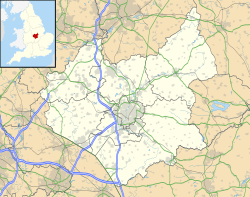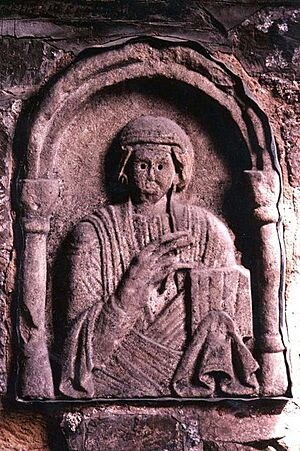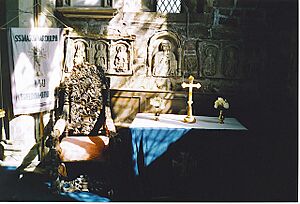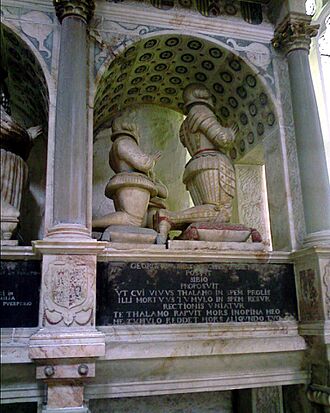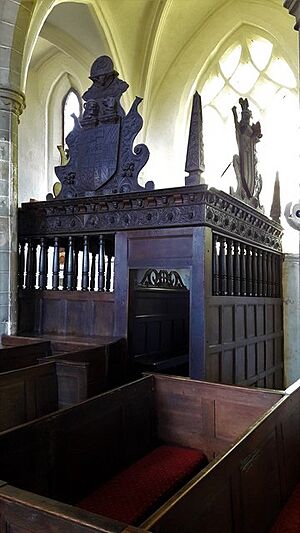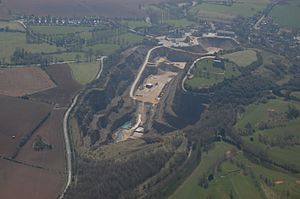Church of St Mary and St Hardulph, Breedon on the Hill facts for kids
Quick facts for kids Breedon Church |
|
|---|---|
| The Church of St Mary and St Hardulph, Breedon on the Hill | |
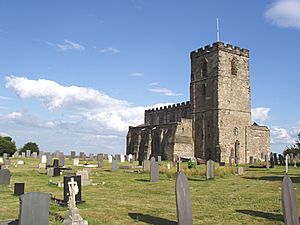 |
|
| 52°48′22″N 1°24′0″W / 52.80611°N 1.40000°W | |
| OS grid reference | SK 406 234 |
| Country | England |
| Denomination | Church of England |
| Churchmanship | Broad Church |
| History | |
| Dedication | St Mary and St Hardulph |
| Architecture | |
| Heritage designation | Grade I listed building |
| Architectural type | English Gothic |
| Administration | |
| Parish | Breedon on the Hill |
| Diocese | Diocese of Leicester |
| Province | Canterbury |
The Priory Church of St Mary and St Hardulph is a special church in Breedon on the Hill, Leicestershire, England. It is part of the Church of England. People also sometimes call it Breedon Priory.
This church stands on top of Breedon Hill. This hill used to be an Iron Age hill fort called The Bulwarks. The village of Breedon on the Hill is south of the hill. Breedon Quarry is on the east side. The church is very important. It is a Grade I listed building. This means it has exceptional architectural interest.
The church you see today was built after an even older building. An Anglo-Saxon monastery, called a minster, was here from the 600s. This church has the largest collection of Anglo-Saxon sculptures. These are some of the best examples of this old art. It also has a special family pew and Renaissance-era church monuments. These monuments belong to the Shirley family. They bought the land of Breedon in 1539. This happened when monasteries were closed down by the King. The biggest monument is for Sir George Shirley. It was made more than 20 years before he died. It even has a life-sized skeleton carved from alabaster.
Contents
History of Breedon Church
The First Monastery: Breedon Minster
An Anglo-Saxon monastery, or minster, was started around the year 675. It was built on the same Iron Age hill fort site. This hill fort was known as the Bulwarks. King Æthelred of Mercia gave his permission for the monastery. He was the third son of King Penda of Mercia. A leader named Frithuric gave the land. He said that Hædda should be the abbot, or head, of the monastery.
Some people believe that four saints were buried here. These saints might have included Frithuric himself. The exact spot of the Anglo-Saxon church and its cemetery is not known today. It was likely lost due to quarrying in the 1900s.
Hædda later became a Bishop of Lichfield. The minster also trained Tatwine. Tatwine was famous for his rhyming riddles. He later became Archbishop of Canterbury from 731 until he died in 734. More land was added to support the minster. King Æthelred of Mercia even bought some land for it. By 1086, most of this land was no longer owned by the minster. The lands around Breedon were given to the de Ferrers family. This happened after William the Conqueror took over England.
Breedon Priory: A New Beginning
Breedon priory was founded around 1120. It was an Augustinian house. This means it was a type of monastery for Augustinian canons. It was built on the same Iron Age hill fort site. This was the same place as the earlier Anglo-Saxon minster.
The priory was a smaller part of Nostell Priory in Yorkshire. There were usually only three to five canons living there. These canons usually came from Nostell. The leaders, called Priors, were also chosen by Nostell. One prior, Gervase, tried to make Breedon Priory independent. But he failed and left in 1244.
In 1441, a bishop visited the monastery. He found it was falling apart and had many debts. By 1535, there were no longer many people living at the priory. Only the prior was there. The priory's yearly income was recorded as £24. 10s. 4d. after expenses.
The priory was closed down in November 1539. This was part of the Dissolution of the Monasteries. The eastern part of the priory, including the central tower, was kept. It was used as the local parish church. The main part of the church, called the nave, and other buildings were later pulled down.
The Church Today
The church has been a Grade I listed building since 1962. This means it is a very important building.
What to See in the Church
Ancient Anglo-Saxon Carvings
The church has many important Saxon carvings. Some of these might be among the oldest in England. These carvings came from the first Saxon abbey church. Even older items have been found on the hill. These include Neolithic tools.
Many early carvings are found around the church. They are often built into the inside walls. They are wrapped in lead sheet. This suggests they were not meant to be part of the building's structure. These carvings are from the 800s. They show Celtic patterns, lions, people, and birds. The birds are shown pecking at vines.
Shirley Family Tombs
The church has many tombs from the 1500s and 1600s. These belong to the Shirley family. This family bought the monastery site. There are two large tomb chests made from Chellaston alabaster. The oldest tomb is for Francis Shirley and his wife. It has carved mourners around the chest. This tomb is from 1571. The other similar tomb is for John Shirley and his wife. It is from 1585. Both of these tombs were made by Richard and Gabriel Royley. They were stonemasons from Burton upon Trent.
The tomb of Sir Francis Shirley was fixed after 60 years. His great-grandson, Thomas Shirley, did the repairs. Thomas wrote that Francis' body was still well preserved. It only had a black mark on one toe. There were no signs of decay. His body was re-wrapped and put back in his tomb.
Three large tombs were built for Sir George Shirley, his father John, and his grandfather Thomas. The biggest monument in the church is for Sir George Shirley. It was made over 20 years before he died in 1622. It is dated 1598 and has three levels.
On the bottom level, there is a realistic skeleton carved from alabaster. This skeleton shows that everyone will eventually die. Having a skeleton like this in the design was unusual for that time.
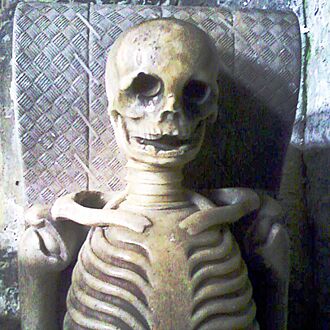
The second level is held up by six pillars. It has two arched spaces. On the right, Sir George Shirley is shown praying. His two sons are behind him. All three figures wear brightly painted clothes from that time. The clothes even have gold details. In the left arch is his wife, who died in 1595. His daughter and two babies are also there. An inscription in Latin says that Shirley's wife died at age 29 while giving birth.
The third level is a stone canopy. It is also held up by six pillars. It has a large, carved coat of arms in the middle. The monument was built from big blocks of alabaster. It was rebuilt in the 1800s by a stonemason named Thomas Allt. He even signed his work.
The Shirley Family Pew
The Shirley family pew was carved in 1627. A pew is a long bench in a church. The other box pews in the church are from the 1700s. The Shirley family pew is now on the left side of the main monument. It is in the north aisle of the church. This wooden structure used to be in the main part of the church. It is now in the vaulted north aisle. This entire aisle was owned by the Shirley family until the 1950s.
Churchyard
The churchyard has one war grave. It belongs to a soldier from the Machine Gun Corps who died in World War I.
Who Was St Hardulph?
St Hardulph is believed by some to be King Eardwulf of Northumbria. This idea comes from a list of saints' burial places from the 1100s. This list says that Saint Hardulph, to whom Breedon was dedicated, was "Ærdulfus rex" (Ærdulf the king). It also says he was buried at Breedon.
Other historians do not connect him to the Northumbrian king. They link a holy man named Hardulf from Breedon to St Modwenna of nearby Burton on Trent. This was recorded by Abbot Geoffrey in the early 1100s. It seems unlikely that a Northumbrian king would be buried and made a saint in Mercia. Especially since Eardwulf is said to have killed St Alkmund of nearby Derby. Of the two ideas from the 1100s, Geoffrey of Burton's story seems more likely.
How the Church is Organized
Breedon parish is part of the Deanery of North West Leicestershire. It is also in the Diocese of Leicester and the Province of Canterbury. It is now part of the Flagstaff Family of Churches. This group includes:
- St Mary the Virgin, Coleorton
- St John's Chapel, Coleorton
- St Matthew's Church, Worthington
- St Helen's Church, Ashby-de-la-Zouch
- Holy Trinity, Ashby-de-la-Zouch
- All Saints Church, Isley Walton
See also


